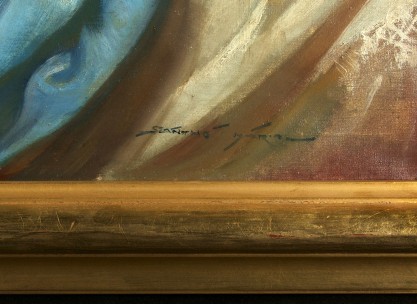


A radiant and lushly executed fine art nude oil painting by the well listed Hungarian artist Maria Szantho, who had a long and decorated career both overseas in Europe and here in the United States. Szantho created three oil paintings depicting her homeland of Hungary for the 1939 World’s Fair in New York City.



This is among the prettiest examples of her nude portraiture we have seen. Painting is housed in a hand made carved basswood gold leafed museum quality frame.
 |
| Above: Verso view shows original pine stretchers and untouched back |
Maria Szantho was born on July 31, 1897 in the city of Szeged which is in the south part of Hungary. She had an extraordinary life, gifted in arts, and achieved fame and international appreciation and honor. Her paintings are well known at galleries and auction houses, and part of many collections.
She married three times. All three of her husbands passed away and she never had any children. Her third husband was Dr. Ferenc Klauschek, hence some sources mention her as Klauschek Ferencne (ne is the equivalent of Mrs. in Hungarian). She signed all her paintings with her maiden name.
Szantho Maria’s first love was music, she was a talented piano player and finished her music studies as a teacher. She earned her diploma at the Hungarian Music Academy on piano faculty. Her diploma was signed by Zoltan Kodaly the famous Hungarian composer.
Shortly after completing her music studies she decided to pursue her interest in painting. She went on several study tours to France and Italy; her rich and detailed naturalist paintings were inspired by the hedonism of Karoly Lotz and the joie de vivre of Gyula Benczur. She studied with and from famous Hungarian painters such as Geza Kukan, Bertalan Karlovszky, Pal Fried and Matyas Vitez.
Maria Szantho exhibited from the mid 1920s at major art galleries such as the Mucsarnok in Budapest. She had an exhibition in Budapest in 1936. She specialized in portraying women posing nude against a landscape, also still lives and portraits. Her models are hedonistically portrayed, she used elements of impressionism and romance. Since her first love was music, her portraits and nudes often permeated with musical themes and idyllic environments enhanced with rich draperies and musical color accords. Banjo, violin or tambourine were some of the musical instruments she depicted.
In 1939 she represented Hungary with three paintings on the New York World’s Fair. The paintings sent to the New York World’s Fair have never been returned to her, or to Hungary because of the beginnings of WW II.
Around 1942 she created the historic work “Legend of the Mythical Stag” (original title: Rege a csodaszarvasrol). The painting created a lot of press echo and it earned her the prestigious Esterhazy Prize. This wall size epic and erotic painting depicted an ancient Hungarian historical scene. Unfortunately it was destroyed in WWII.
In the early 1950s the Embassy of the Soviet Union contacted her and asked her to paint a huge portrait of Stalin. She objected saying that materials are scarce, she did not have access to a large canvas. The Soviets arranged to ship her a huge canvas from Moscow. Stalin passed away unexpectedly in 1953, so she did not have to paint the portrait. They never asked her to give back the canvas which she put to better use.
Maria Szantho’s main foreign markets were Japan and the United States of America. She also had many private orders from abroad and Hungary. After WW II in the communist Hungary one was not allowed to sell privately to western countries, so she had to use the government owned foreign trading company Artex to export her paintings. Some of her then exported and her pre WW II paintings are periodically offered at auction.
On her 100th birthday on July 31st, 1997 a Minister of the Hungarian Republic greeted her on her birthday party at Nagymagocs, Hungary. On October 23, 1997 she received one of the highest official Hungarian recognitions. Arpad Goncz the then President of the Republic of Hungary awarded her with the decoration of the Officer’s Grand Cross of the Hungarian Republic to honor her lifetime achievement.
